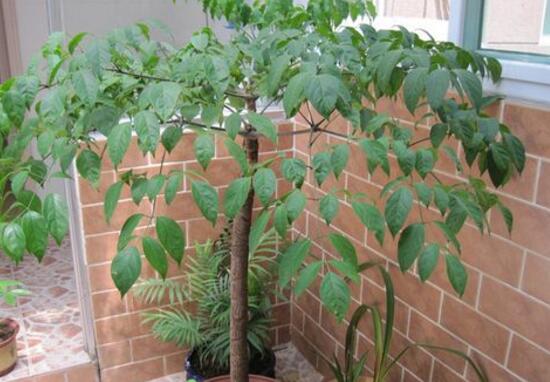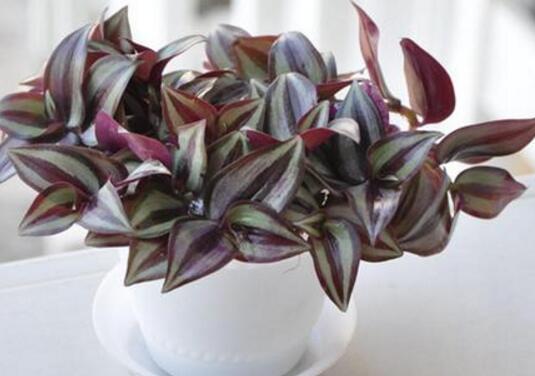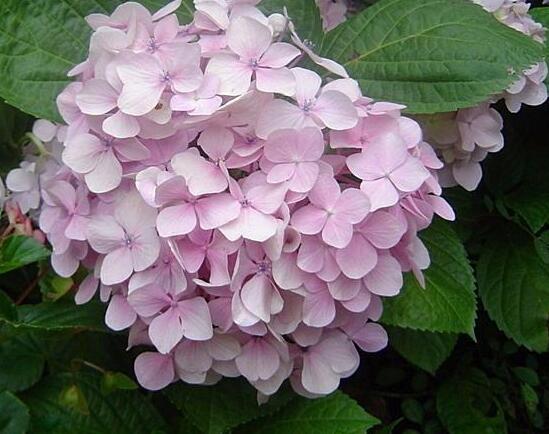Happiness tree how to make its stem thick, learn seven tricks to make it grow thick and strong / peeling off the top is the key
The beauty of the happiness tree lies not only in its beautiful name, but also in its robust plant type, but once the plant grows very thin and tall, it will seriously affect its beauty, so how does the happiness tree make its stem thick? In this regard, according to the growth habits of the happiness tree, the editor summarizes seven robust ways to make the happiness tree grow, and then go with the editor to have a look.
First, the happiness tree how to make the stem thick, there are 7 ways

As a beautiful potted plant, if you raise the happiness tree well, it will be very ornamental, but sometimes it is easy to grow very thin and tall, affecting beauty. As for how Happiness Tree thickens its stems, the editor summarizes seven points: ① topping; ② pruning; ③ watering; ④ fertilization; ⑤ changing pots; ⑥ basking in the sun; and ⑦ keeping the basin soil moist.
1. Take off the top
If you want the stem of the happiness tree to grow stout, the first thing to do is to take off the top. You can cut off the buds at the top of the happiness tree so that it can't grow upward. In addition, after picking the top, you can also let the happiness tree get more nourishment, so that its stem can grow thick.
2. Pruning
In addition to taking off the top, proper pruning will also make the stem of the happiness tree thick. Specific approach: if the branches on the side of the happiness tree are also very thick, we can help cut off some of them moderately, so that the excess nutrients can be transferred to the stem, and it will naturally grow stronger. As for how to prune, there is a detailed introduction in the pruning method of the happiness tree, so I won't say much here.
3. Watering
How does the happiness tree make its stem thick? Watering is a good way to do this: often sprinkle some water on the stem of the happiness tree. after doing so, you can keep the stem of the happiness tree wet and make it grow stronger.
4. Fertilization
When it comes to watering and fertilizing, it is the main factor in the growth and thickness of the stem of the happiness tree. Specific approach: we can add some potash fertilizer to it, so that the nutrients in the soil will increase, pay attention to the fertilizer can not be too much. After doing so, the stem of the happiness tree has more nutrients to absorb, and it is only a matter of time before it grows stronger.
5. Change the basin
How does the happiness tree make its stem thick? We can also in the right season, help it change the basin, the growth space of the happiness tree becomes larger, its stem can grow quickly, can grow thicker.
6. Bask in the sun
Happiness tree likes light, give it enough light, can promote plant growth, so happiness tree how to make the stem thick, we should often let it bask in the sun, of course, can not expose. In addition, the temperature should be controlled at about 20 degrees Celsius, which is most conducive to its growth and can grow faster and thicker.
7. Keep the basin soil moist
Happiness trees like a humid environment, so it is critical to keep the basin soil moist. In this regard, we can follow the watering method of the happiness tree. Of course, the water can not be too intense, can not be too much, otherwise it is easy to rot the root, so it is best to water it once in about 3 days in order to be more sturdy.
Of course, people are alive, the method is dead, we can carry out maintenance according to the actual situation. Generally speaking, as long as we follow the cultivation method of the happiness tree, the happiness tree will grow very well. About the happiness tree how to make the stem thick, the editor introduced here, hoping to bring help to everyone.
How to prune the happiness tree, the pruning method of the happiness tree is very important.
Happiness tree, a beautiful ornamental plant, grows very fast and grows luxuriantly without paying attention to it. And if we want to ensure the beauty of the happiness tree, like human hair, we have to prune it properly, then how to prune the happiness tree? In order to cultivate a beautiful happiness tree, the editor will bring you a diagram of the pruning method of the happiness tree.
How to prune the happiness tree, the method is very important
As a flower lover, we should not only know the cultivation method of the happiness tree, but also know the pruning method of the happiness tree, so that we can make the happiness tree beautiful! Fertilization is the key to how to thicken the stem of the happiness tree, and the key to how to prune the happiness tree lies in the method. In this regard, the editor summed up four pruning methods: heart-picking, hair wiping, thinning and styling, and we move on.
Second, the diagram of the pruning method of the happiness tree.
1. Pick the heart and bloom more
For tree-shaped potted plants, it is critical to pick the heart when pruning, which also applies to the happiness tree. Heart-picking method: cut off the main stem of the happiness tree, or the top of the side branch, with scissors, or you can pinch it off directly with your hands. After doing so, it can prevent the excessive growth of branches, promote the plant to be more branched, and form a multi-flower head and beautiful plant shape.
2. Wipe your head and control the height
How to prune the happiness tree, in addition to picking the heart, wiping the head is also very important. Specific approach: the top part of the happiness tree, all cut off! Wipe your head, suitable for a large happiness tree, because you can't let it grow too tall if you keep it at home, so you need to prune it by wiping your head.
3. Thinning and cutting to promote growth
Thinning is one of the simplest pruning methods of the happiness tree: cut off the overdense branches or leaves to improve the ventilation and light transmission conditions, so that the happiness tree grows stronger and the flowers and fruits are more colorful. Note: thinning should be carried out along the branch extension direction, sparse degree.
4. Stereotyping
In addition to the above, stereotyping is also one of the pruning methods of the happiness tree. It is understood that the flowers of the happiness tree are erect, terminal and night-blooming, and when we prune the happiness tree, we should prune the effect that we want the happiness tree to grow into. This is stereotyping, which requires us to simulate the pruning effect in our minds. This method is suitable for experienced florists.
Generally speaking, pruning is a technical job, which not only requires skill, but also requires you to be patient, otherwise it will be worse and worse if you cut everything and get worse and worse. Therefore, in order to raise a beautiful happiness tree, we should master the pruning method of the happiness tree, and finally wish everyone to cut off the beautiful happiness tree.
Methods and techniques of culturing potted turtles to carry bamboo
Tortoise back bamboo likes warm, humid, semi-shady environment, not cold-resistant, indoor temperature more than 10 ℃ will not be hurt, the optimum growth temperature is about 30 ℃, avoid direct sunlight and drying. It grows well in loose soil rich in humus. The propagation method of tortoise back bamboo can be propagated by pressing and cutting, and generally by cutting.
Cultivation tips: cultivation of tortoise back bamboo, usually in the middle and late May, cut the stem of the larger female parent plant, each cuttings need to take 2-3 stem nodes, with leaves to insert the stem segment into the basin, 1 plant in each pot. The basin soil usually uses rotten leaf soil, peat soil and river sand. After getting into the basin, it is necessary to pour water thoroughly and place it in a ventilated and semi-shady place. Always keep the basin soil moist. When the temperature is 25-30 ℃, it can take root in 4-6 weeks, and new buds can be expected to grow into new plants in 10 weeks. During the growing period, the watering should be adequate, and the basin soil should always be kept moist, but not stagnant water, such as long-term stagnant water, which can easily cause rotten roots and even lead to the death of the whole plant. In addition to watering in dry and hot weather, spray water on the leaves and the ground several times a day to keep the air moist.
After the beginning of autumn. Watering should be reduced gradually. After the beginning of winter, the basin soil should be slightly dry. Low temperature in winter, reduce watering, such as too much watering, basin soil is too wet for a long time, but also easy to cause rotten roots, yellow leaves, or even the death of the whole plant. In winter, the leaf surface should be sprayed with warm water every 3 to 5 days to keep the leaf surface clean and bright. Thin and rotten bean cake water should be applied every 14 days. In addition to liquid fertilizer, topdressing outside the roots should be applied for 2 times in the peak growing season. 0.1% urea and 0.1% potassium dichlorophosphate mixed aqueous solution can be used to make the stems and leaves large and green.
Except for oblique light visible in winter, the room temperature should be kept above 10 ℃, and the cold wind should be avoided, otherwise the leaves would yellowing and falling off. Shade should be maintained in other seasons, but the interior must be bright. It is necessary to strengthen ventilation, otherwise shell insects will occur if the basin soil is too wet. The tortoise bamboo grows faster in the south, so it is appropriate to change the basin of No. 1 every spring. When changing the basin, it is necessary to replace it with 1p and 3 newly cultivated soil, add one rotten compost, and add an appropriate amount of organic fertilizer such as bean cake and bone meal as base fertilizer. When changing the basin, if the root is too much or too long, it needs to be pruned properly.
- Prev

How to apply fertilizer, what fertilizer to apply / how long to apply fertilizer (with detailed method)
Among the many plants, the adaptability of Dioscorea przewalskii is relatively strong, but if you want to grow well, the correct fertilization method is particularly important, so how to fertilize more scientifically? The editor brings you to know more about it.
- Next

How to raise the eight Immortals, the cultivation methods and matters needing attention / humidity are very important.
The eight Immortals, also known as Hydrangea, is now a very famous ornamental plant flower, so the eight Immortals we see usually appear in front of us as garden flowers, so how to raise the beautiful eight Immortals? the following will introduce the breeding methods and matters needing attention of the eight Immortals.
Related
- Fuxing push coffee new agricultural production and marketing class: lack of small-scale processing plants
- Jujube rice field leisure farm deep ploughing Yilan for five years to create a space for organic food and play
- Nongyu Farm-A trial of organic papaya for brave women with advanced technology
- Four points for attention in the prevention and control of diseases and insect pests of edible fungi
- How to add nutrient solution to Edible Fungi
- Is there any good way to control edible fungus mites?
- Open Inoculation Technology of Edible Fungi
- Is there any clever way to use fertilizer for edible fungus in winter?
- What agents are used to kill the pathogens of edible fungi in the mushroom shed?
- Rapid drying of Edible Fungi

